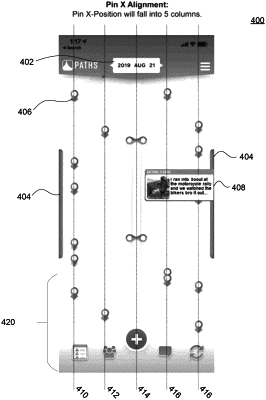| CPC G06Q 50/01 (2013.01) [G06F 3/04842 (2013.01); G06Q 10/1093 (2013.01)] | 21 Claims |

|
1. A computer-implemented method for dynamically displaying memory cues comprising aggregated social media/calendar content in a graphical user interface (GUI), the method comprising:
displaying a date selector configured to retrieve an input from a user, the input comprising information about a selected date of interest to the user;
retrieving first memory cues comprising first social media/calendar content associated with the user from one or more social media services;
displaying a first graphical element corresponding to the user content containing the retrieved first social media/calendar content within a first portion of the GUI on a computer screen;
retrieving second memory cues comprising second social media/calendar content associated with one or more other users from the one or more social media services;
displaying a second graphical element corresponding to the one or more other users' content containing the retrieved second social media/calendar content within a second portion of the GUI on a computer screen; and
automatically applying a content organization process, executed by a processor, to dynamically display aggregated social media/calendar content within the GUI, the process comprising:
a) analyzing the retrieved first and second social media/calendar content based on time stamps or event dates;
b) determining the chronological order of the analyzed content;
c) grouping and organizing the analyzed content based on temporal proximity and relevance to the selected date;
d) generating a Tandem Timeline being a unified display element within the GUI that presents shared memory cue content comprising the organized social media/calendar content while preserving the chronological order, wherein the Tandem Timeline visually represents the first and second social media/calendar content along a visual timeline axis, wherein the Tandem Timeline is configured to enable a plurality of users to modify the first and second social media/calendar content, the plurality of users comprising the user and the one or more other users, and wherein the user interacts with the Tandem Timeline to cause the GUI to navigate temporally through the first and second social media/calendar content; and
e) generating a CollabTab feature graphical element within the GUI, wherein the user interacts with the CollabTab feature graphical element to cause the GUI to navigate between the first and second graphical elements corresponding collectively to the shared memory cue content, wherein the CollabTab enables collaboration of the shared memory cue content, wherein the CollabTab graphical element comprises a plurality of tabs, each tab of the plurality of tabs being associated with a unique memory cue content contributor selected from the plurality of users, wherein the CollabTab permits the user to toggle between contributions from each memory cue content contributor.
|